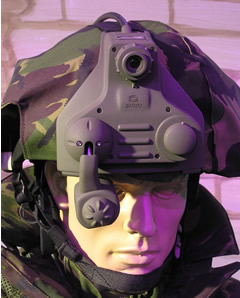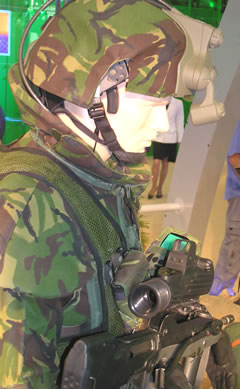 FELIN is a modular infantry combat suite, offering efficient ergonomics, autonomy and weight saving. In March 2004 Sagem won the DGA contract to develop and produce up to 30,000 infantry combat suits, to field with all French Army active infantry regiments beginning in mid 2010, as part of the future air/ground system of systems called BOA. The total contract worth is estimated at about one billion Euro including development, engineering and production of close to 31,500 suites.
FELIN is a modular infantry combat suite, offering efficient ergonomics, autonomy and weight saving. In March 2004 Sagem won the DGA contract to develop and produce up to 30,000 infantry combat suits, to field with all French Army active infantry regiments beginning in mid 2010, as part of the future air/ground system of systems called BOA. The total contract worth is estimated at about one billion Euro including development, engineering and production of close to 31,500 suites.
FELIN systems will comprise a modified weapon system, integral sensors, wearable computer, communications and display systems, advanced uniform, protection and headgear. At an advanced stage it will also include team allocated equipment such as ODIN mini-UAV, robotic mule and commander’s specific equipment. The weight of the entire FELIN system will be 24 kg, including weaponry, energy, ammunition, water and food.
Clothing
Superior resistance, comfort and stealth will enable the soldier to move faster with extra protection. The uniforms are designed for sufficient ventilation, and are fabricated from fire retardant materials, replacing current fire retardant coveralls used AFV crews. Torso protection will be improved removable modular combat jacket which will have significantly larger protection area, provided by soft, rather than hard ballistic protection plates. It will be supplemented by ceramic inserts for extra protection of critical areas, when required by the mission or threat level. The garment’s structure will be modular, allowing the soldier to adjust the weight according to the mission. The suite will also be provided in a special Nuclear, Radiological, Bacteriological and Chemical protection configuration.
The Weapon System
The FELIN infantryman will use an upgraded FAMAS assault rifle which has been fitted with image intensifying (I2) sight and a wireless video camera that relay the sight images over wireless local network to either the torso or helmet displays, or directly to transmits them to the platoon commander or team leader. The commander’s FAMAS will be equipped with thermal weapon sights. IR optronics will also increase the effectiveness of the Minimi machine gun and the FRF2 sniper rifle. FELIN V1 will field with four types of sights – a reflex day/night sight for the FAMAS, a day/night sight for Minimi, an improved long-range day/night (I2) sight integrated with a laser rangefinder for the FR-F2 sniper rifle and hand held imager, integrated with GPS, LRF and Digital Magnetic Compass (DMC) for commanders.
Electronics Systems
 The helmet offers enhanced protection with an outer layer that contains a wide-angle day/night camera improving dismounted soldier’s mobility in both day and night combat, relaying images to the helmet ocular, or thorax display unit. The soldier does not use a microphone for voice commands, but instead wears a headband with an osteo-phone. The helmet will also be equipped with passive elements for audio protection. The helmet mounted day/night microcamera will offer 50 degrees field of view. Using the standard headgear, the soldier will be able to detect a human target at 150 meters and identify it at a range of 70 meters.
The helmet offers enhanced protection with an outer layer that contains a wide-angle day/night camera improving dismounted soldier’s mobility in both day and night combat, relaying images to the helmet ocular, or thorax display unit. The soldier does not use a microphone for voice commands, but instead wears a headband with an osteo-phone. The helmet will also be equipped with passive elements for audio protection. The helmet mounted day/night microcamera will offer 50 degrees field of view. Using the standard headgear, the soldier will be able to detect a human target at 150 meters and identify it at a range of 70 meters.
The wearable computer (PEP), the hub of FELIN system is built around a high speed processor and USB 2.0 high speed, open universal port interfaces which controls the energy and links with different components, such as imaging sensors, weapon, displays, radio etc. The computer is connected to a man-machine interface enabling the soldier to control the system and carry out operations such as firing around a corner or see through obstacles.
The infantryman will use a small personal radio (RIF) transmitting voice and data communication. The RIF will be functional both in mounted or dismounted operations enabling GPS position tracking and information sharing within the squad and platoon. The communication bandwidth provided by the RIF is sufficient to pass operational graphics, imagery, maps and video sequences between team members and back to the higher echelon. They will operate with either all-in-one or sub-network architecture and interface with the fourth generation radio (PR4G) which remains the link between the dismounted platoon and the vehicles. As it is separated from the PEP computer, the radio will operate even in the event of computer breakdown. FELIN platoon will operate five networks: four will operate as RIFintra squad networks, (three infantry and one antitank squads) maintaining continuous and open “conference” between the squad members. Each RIFIntra network will also be separable into two intra-team sub-networks, allowing control of small team operations when required. At the platoon level, RIF Command network will operate, communicating between squad leaders, platoon commander, CO, snipers and the unit’s armored personnel carriers.
 Each section commander will be equipped with multifunction, un-cooled thermal binoculars used for day/night observation and targeting. The specialized section commanders will get portable information system terminals, (SIT), which are PDA sized digital assistants, used for tactical situation assessment. The SIT will display images, maps with overlaid symbology, and will be able to exchange encrypted messages with other commanders and higher echelons.
Each section commander will be equipped with multifunction, un-cooled thermal binoculars used for day/night observation and targeting. The specialized section commanders will get portable information system terminals, (SIT), which are PDA sized digital assistants, used for tactical situation assessment. The SIT will display images, maps with overlaid symbology, and will be able to exchange encrypted messages with other commanders and higher echelons.
The FELIN electronic ensemble will be powered by two rechargeable Li-ion batteries will be used to ensure that the soldier can operate the system for 24 hours once dismounted. The unit will also be equipped with a collective fuel-cell based battery charger, which will sustain the team for two more days of continuous dismounted operation. Batteries can be recharged using collective devices. These will be integrated into the futuristic EBRC, AMX-10P, VBCI and VAB armored vehicles, in support of FELIN equipped infantry teams.
















